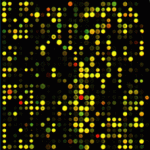Genomics
|
23 january 2015 05:47:58 |
| Comparative proteomics analysis of differential proteins in respond to doxorubicin resistance in myelogenous leukemia cell lines (Proteome Science) |
|
Tweet Background:
Chemoresistance remains a significant challenge in chronic myelogenous leukemia (CML) management, which is one of the most critical prognostic factors. Elucidation the molecular mechanisms underlying the resistance to chemoresistance may lead to better clinical outcomes.
Results:
In order to identify potential protein targets involved in the drug-resistant phenotype of leukemia, especially the chronic myelogenous leukemia (CML), we used a high-resolution ?ultra-zoom? 2DE-based proteomics approach to characterize global protein expression patterns in doxorubicin-resistant myelogenous leukemia cells compared with parental control cells. Ultra-high resolution of 2DE was achieved by using a series of slightly overlapping narrow-range IPG strips during isoelectric focusing (IEF) separation. A total number of 44 proteins with altered abundances were detected and identified by MALDI-TOF or LC-MS/MS. Among these proteins, enolase, aldolase, HSP70 and sorcin were up-regulated in doxorubicin-resistant myelogenous leukemia cell line, whereas HSP27 was down-regulated. Some of the results have been validated by Western blotting. Both enolase and aldolase were first reported to be involved in chemoresistance, suggesting that process of glycolysis in doxorubicin-resistant myelogenous leukemia cells was accelerated to some extent to provide more energy to survive chemical stress. Possible roles of most of the identified proteins in development of chemoresistance in myelogenous leukemia cells were fully discussed. The results presented here could provide clues to further study for elucidating the mechanisms underlying drug resistance in leukemia.
Conclusions:
As a whole, under the chemical stress, the doxorubicin-resistant myelogenous leukemia cells may employ various protective strategies to survive. These include: (i) pumping the cytotoxic drug out of the cells by P-glycoprotein, (ii) increased storage of fermentable fuel, (iii) sophisticated cellular protection by molecular chaperones, (iv) improved handling of intracellular calcium, (v) increased glucose utilization via increased rates of glycolysis. In the present study, proteomic analysis of leukemia cells and their drug resistant variants revealed multiple alterations in protein expression. Our results indicate that the development of drug resistance in doxorubicin-resistant myelogenous leukemia cells is a complex phenomenon undergoing several mechanisms. |
| 87 viewsCategory: Biochemistry, Genomics |
 Effects of mycophenolate mofetil on kidney function and phosphorylation status of renal proteins in Alport COL4A3-deficient mice (Proteome Science) Effects of mycophenolate mofetil on kidney function and phosphorylation status of renal proteins in Alport COL4A3-deficient mice (Proteome Science)Proteomics analysis of urine reveals acute phase response proteins as candidate diagnostic biomarkers for prostate cancer (Proteome Science) 
|
| blog comments powered by Disqus |
MyJournals.org
The latest issues of all your favorite science journals on one page
The latest issues of all your favorite science journals on one page



